
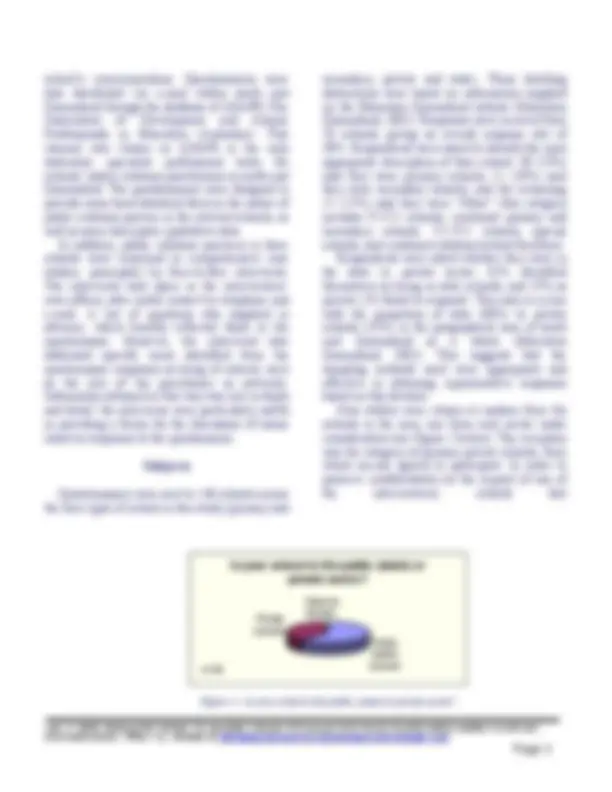
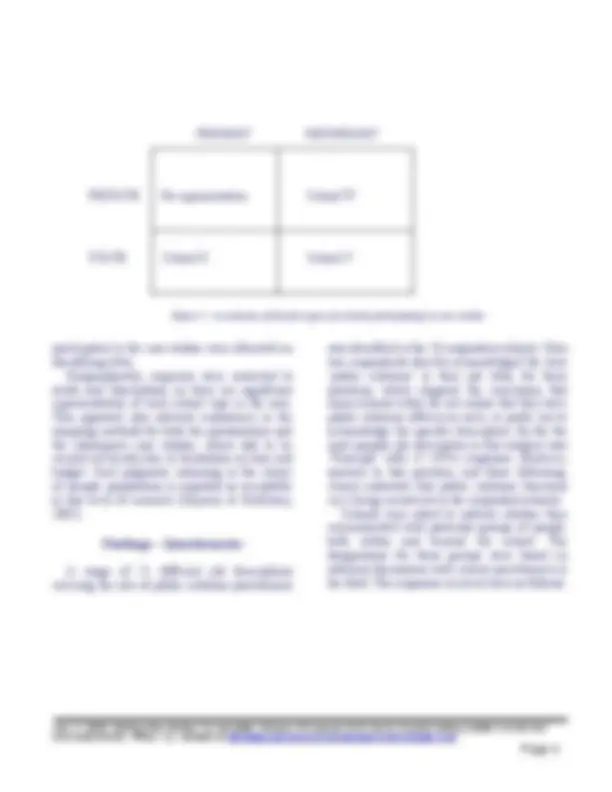
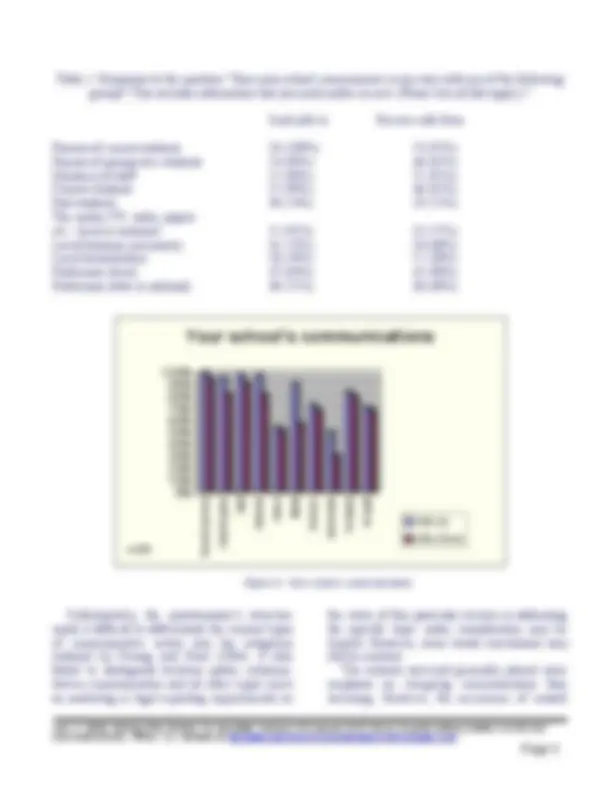
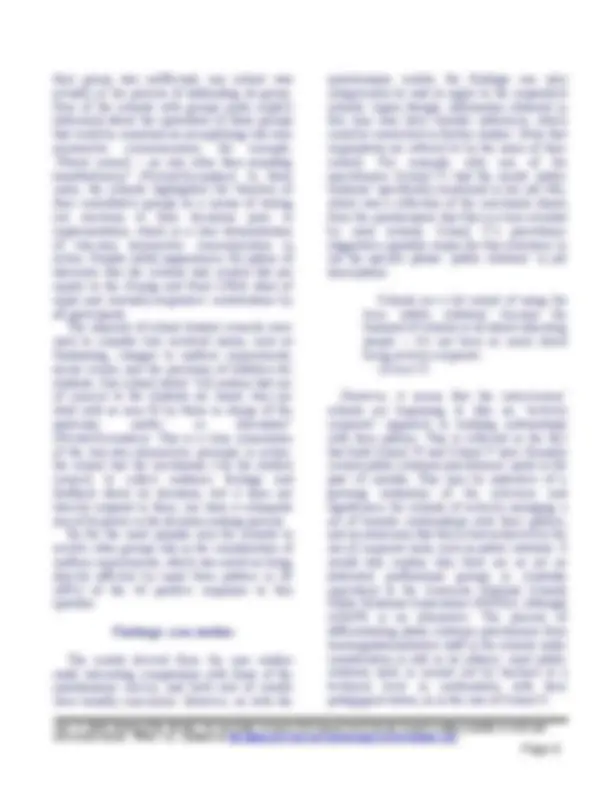
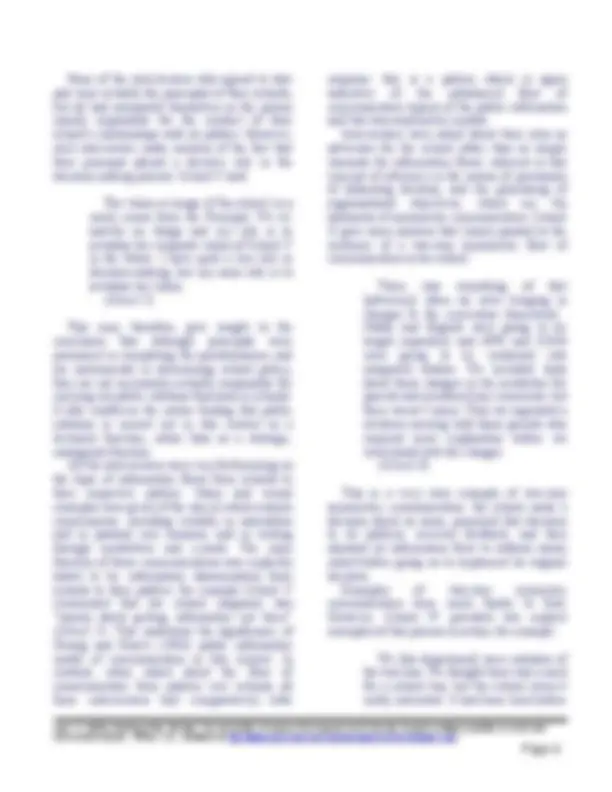
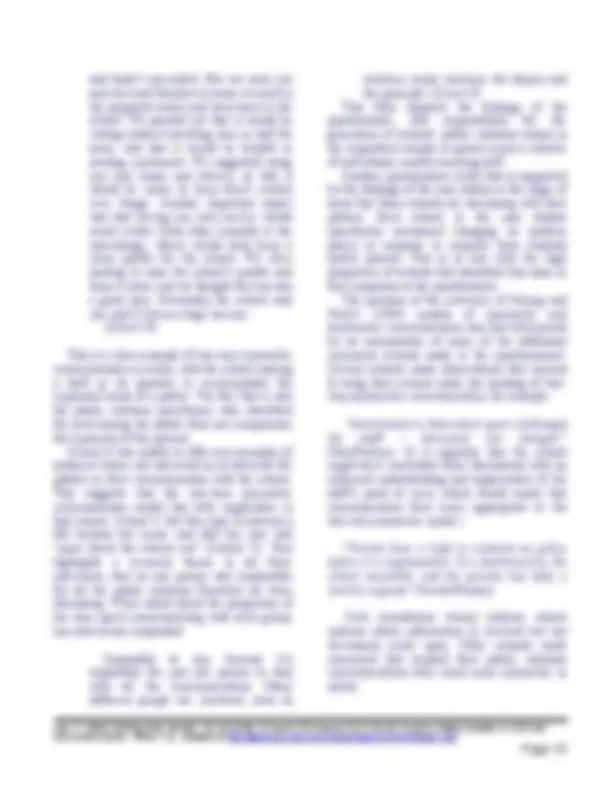
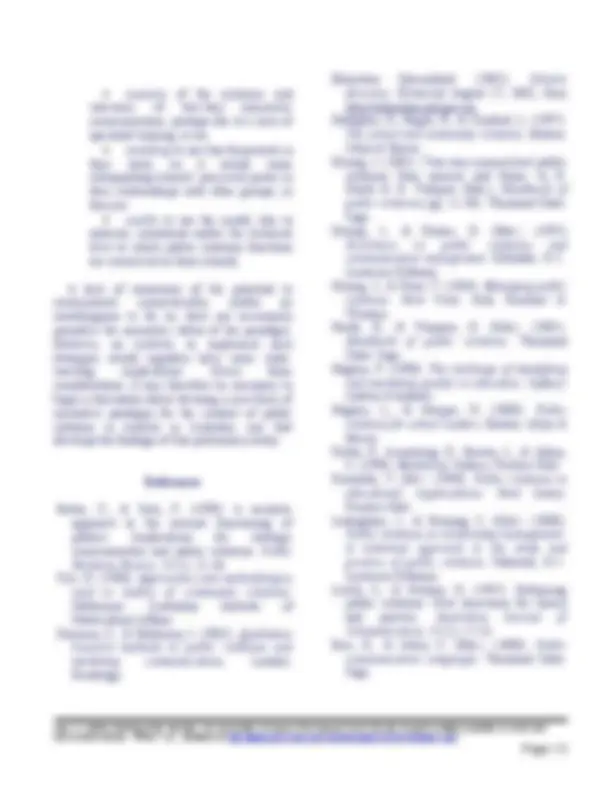



Study with the several resources on Docsity

Earn points by helping other students or get them with a premium plan


Prepare for your exams
Study with the several resources on Docsity

Earn points to download
Earn points by helping other students or get them with a premium plan
Community
Ask the community for help and clear up your study doubts
Discover the best universities in your country according to Docsity users
Free resources
Download our free guides on studying techniques, anxiety management strategies, and thesis advice from Docsity tutors
The applicability of James Grunig and Todd Hunt's public relations theories to the roles of practitioners in schools in South East Queensland. The study aims to determine which of their four models best describes the practice of public relations in these schools.
What you will learn
Typology: Exams
1 / 14

This page cannot be seen from the preview
Don't miss anything!









Anne Lane Griffith University
This article examines the relevance of James Grunig and Todd Hunt’s (1984) theories to public relations practitioners’ roles in south east Queensland schools. It focuses in particular on the two-way symmetric model in this context. The geographical boundaries of the research mean that this article is intended primarily as an exploratory, descriptive analysis of a specific area rather than an exhaustive treatise on the general topic of public relations in Australian schools. However, it is hoped that it will prove useful in identifying bases for further study and discussion.
This project’s theoretical framework comes from Grunig and Hunt’s influential work Managing Public Relations (1984), which describes four classic public relations models. Grunig and Hunt are among the foremost authors of theory in the field, and their work has been widely critiqued. Although their theories are nearly twenty years old, there have been few major challenges to their importance in the field of public relations, and the text is still widely used and cited in many public relations courses and readings at tertiary level (see for example Grunig & Dozier, 1992; Ledingham & Bruning, 2000; Rice & Atkin, 2000; and Heath & Vasquez, 2001). However, studies specifically using Grunig and Hunt’s four models to analyse public relations in schools are limited (Gallagher, Bagin, & Kindred, 1997), and in Australian schools seemingly non- existent. In Managing Public Relations (1984), Grunig and Hunt identified four theoretical public relations paradigms: press agentry/publicity, public information, two-way asymmetric, and two-way symmetric. For the purposes of this article, it is appropriate to clearly define these
paradigms, since subsequent discussion hinges on the precise nature of these definitions as given by Grunig and Hunt (1984):
Initially, Grunig and Hunt (1984) advocated the symmetric model alone as the ideal form of public relations, but later Grunig (2001)
Lane, A. (2003). Working at the interface: The descriptive relevance of Grunig and Hunt’s theories to public relations practices in south east Queensland schools. PRism 1 (1). Available at: http://www.praxis.bond.edu.au/prism/papers/refereed/paper1.pdf
acknowledged that this model by itself might be inadequate for the contemporary public relations practitioner. Instead he proposed a model somewhere between the symmetric and the asymmetric, a concept that he called “a new model of excellent, two-way public relations” (Grunig, 2001, p.26). However, the inclusion of the principles of two-way symmetric communication was regarded as paramount.
The aim of this study was to establish which – if any – of Grunig and Hunt’s four models best describes the practice of public relations in schools in south east Queensland. Additionally, it was intended that the normative status of the two- way symmetric model be assessed in this particular context. Such questions make the basic assumption that public relations is actually being practiced in these schools: that is, that they have formal, organised relations with their publics. This implicit assumption was also therefore examined in the research for this article. The research was structured around three specific questions:
Before the methods used in this research are described more closely, it is important to acknowledge that throughout this article the communication relationship between schools and their publics is only considered from the point of view of the schools. In the broader context of
public relations theory, a criticism that is sometimes levelled at the work of Grunig and Hunt is that the organisation becomes the object- viewer and publics are merely reactionary, existing and having importance only as a response to that organisation (see for example Leitch & Neilson 1997, and Botan & Soto, 1998). It is also worth noting that this research has been carried out at a limited number of schools in a limited geographical area, and that resulting idiosyncrasies may make it inappropriate to extrapolate the results further. However, the information derived will provide a starting point for future discussions and research in this area. With these caveats in mind, two survey instruments – questionnaires and case studies – were addressed to schools in south east Queensland. These instruments combined elements of both quantitative and qualitative research techniques, underpinning the benefits of a qualitative approach with the strengths of a quantitative methodology (for further discussion on this approach see Cox, 1986). The initial aim of the research was to contact as many schools as possible in south east Queensland across the public and private sectors at both primary and secondary level. All 96 schools on the Gold Coast were contacted, plus an additional 52 in other parts of the target area as defined by Education Queensland (Education Queensland, 2002). Questionnaires were chosen as the best way to seek information from such a large number of respondents. It was important to at least aim for blanket coverage as this is such an uncharted area, and it was vital to obtain as much information as possible. A large sample also reduced the likelihood of “response bias” (Wimmer & Dominick, 1997, p. 161), whereby one or two responses may have a disproportionate effect on outcomes. Once relevant permission was obtained from Education Queensland and Brisbane Catholic Education, questionnaires were mailed out to all the selected schools. Instructions were given that they were to be completed by the person in the school who had major responsibility for the
Lane, A. (2003). Working at the interface: The descriptive relevance of Grunig and Hunt’s theories to public relations practices in south east Queensland schools. PRism 1 (1). Available at: http://www.praxis.bond.edu.au/prism/papers/refereed/paper1.pdf
PRIVATE No representation School W
STATE School X School Y
Figure 2 - A summary of the four types of schools participating in case studies
participated in the case studies were allocated an identifying letter. Geographically, enquiries were restricted to south east Queensland, as there are significant representations of each school type in the area. This approach also allowed consistency in the sampling methods for both the questionnaire and the subsequent case studies, which had to be carried out locally due to limitations on time and budget. Such pragmatic reasoning in the choice of sample populations is regarded as acceptable at this level of research (Daymon & Holloway, 2002).
A range of 21 different job descriptions covering the role of public relations practitioners
was identified in the 56 respondent schools. Only two respondents directly acknowledged the term ‘public relations’ in their job titles for these positions, which supports the conclusion that many schools either do not realise that they have public relations officers as such, or prefer not to acknowledge the specific description. By far the most popular job description in this category was ‘Principal’ with 25 (45%) responses. However, answers to this question, and those following, clearly indicated that public relations functions were being carried out in the respondent schools. Schools were asked to indicate whether they communicated with particular groups of people, both within and beyond the school. The designations for these groups were based on informal discussions with current practitioners in the field. The responses received were as follows:
Lane, A. (2003). Working at the interface: The descriptive relevance of Grunig and Hunt’s theories to public relations practices in south east Queensland schools. PRism 1 (1). Available at: http://www.praxis.bond.edu.au/prism/papers/refereed/paper1.pdf
Table 1: Responses to the question “Does your school communicate in any way with any of the following groups? This includes information that you send and/or receive (Please tick all that apply.)”
Send info to Receive info from
Parents of current students 56 (100%) 53 (95%) Parents of prospective students 54 (96%) 46 (82%) Members of staff 55 (98%) 51 (91%) Current students 55 (98%) 46 (82%) Past students 30 (54%) 29 (52%) The media (TV, radio, papers etc – local or national) 51 (91%) 32 (57%) Local business community 41 (73%) 34 (68%) Local householders 28 (50%) 17 (30%) Politicians (local) 47 (84%) 45 (80%) Politicians (state or national) 40 (71%) 38 (68%)
Parents (current)
Parents (pros)
Staff Students
AlumniMedia Business Households Pol (local)Pol (nat)
Your school's communications
Info to Info from n=
Figure 3 – Your school’s communications
Unfortunately, the questionnaire’s structure made it difficult to differentiate the various types of communicative action into the categories outlined by Grunig and Hunt (1984). It also failed to distinguish between public relations- driven communication and all other types (such as marketing or legal reporting requirements) so
the value of this particular section in addressing the specific topic under consideration may be limited. However, some broad conclusions may still be reached. The schools surveyed generally placed more emphasis on out-going communication than incoming. However, the occurrence of inward
Lane, A. (2003). Working at the interface: The descriptive relevance of Grunig and Hunt’s theories to public relations practices in south east Queensland schools. PRism 1 (1). Available at: http://www.praxis.bond.edu.au/prism/papers/refereed/paper1.pdf
This again is further clear confirmation that public relations is being practiced in the schools under consideration. Respondents were also asked who was responsible for creating this output. Most schools reported a number of different people sharing the responsibilities for the creation and production of public relations collateral: 35 of the 56 respondents (63%) indicated that three or more different people were involved. Respondents indicated that many members of the school community are involved in the practice of public relations, from the secretary who composes and compiles the weekly newsletter to the administration staff who send out media releases. Public relations functions, with the sole exception of web site management, are practiced exclusively in-house by the respondent schools: most allocated these public relations functions to teachers (in addition to their pedagogical duties) or administrative staff. This would support the conclusion that public relations in schools is being practiced as a technical function, rather than as a specialised, management role. It was also apparent that there was no significant input acknowledged from non-school personnel in any of the categories, apart from the fundraising plans. Schools are neither seeking input from, nor responding to, input from their publics in the creation of these items, and therefore in the school behaviours and policies they outline. The most likely descriptor of this type of communication – using the theories of Grunig and Hunt (1984) – would therefore be the public information model, although the two-way asymmetric model would be more relevant to promotional communication. In the category of fundraising, various organisations of parents and friends were credited with a significant input, indicating a level of two-way communication. Of the 34 respondent schools that indicated they had formal fundraising plans, 21 (62%) stated that parents and friends were involved solely or jointly in the construction of those plans. This seems therefore to be an area in
which schools are willing to listen to and act upon the views of members of their publics in the determination of school policy and behaviour; a clear example of two-way symmetric communication in action. More research would be necessary to discover the reason for this accessibility, but perhaps schools feel that as parents are largely responsible for the raising of funds, it is only right that they be involved in the planning. In response to further questions, all schools indicated that they had sent out enrolment packages containing promotional information in response to telephone enquiries. As this information is subjective and persuasive in its intention, it cannot be classified under the public information model. It may be described as falling under Grunig and Hunt’s (1984) definition of two-way symmetric communication in its most literal sense, as the schools are directly responding to a request from a public. However, because the school is not actually changing or modifying its behaviour, and is primarily concerned with sending out communication, it more closely resembles the two-way asymmetric model. Three schools noted that they subsequently rang prospective parents to discuss their responses to the enrolment package, but none noted whether there was any reaction by the school to any issues raised. Schools were next asked whether they incorporated some sort of consultative group in the governance of their organisation, and if so, what areas these groups addressed. An overwhelming majority (91%) of respondent schools said they did have such groups. They were reported to have responsibility for strategic planning and operations within the schools in a variety of areas. This might indicate that these schools were making a determined effort to create a channel for the free and equal flow of information. However, almost half (47%) of the 51 schools with a consultative group did not acknowledge that the group had any impact on school policy. Two of these explicitly stated that
Lane, A. (2003). Working at the interface: The descriptive relevance of Grunig and Hunt’s theories to public relations practices in south east Queensland schools. PRism 1 (1). Available at: http://www.praxis.bond.edu.au/prism/papers/refereed/paper1.pdf
their group was ineffectual; one school was actually in the process of disbanding its group. Four of the schools with groups made explicit statements about the operations of those groups that could be construed as exemplifying two-way asymmetric communication: for example, “Parent council – no role other than sounding board/advisory” (Private/Secondary). In these cases, the schools highlighted the function of their consultative groups as a means of testing out reactions to their decisions prior to implementation, which is a clear demonstration of two-way asymmetric communication in action. Despite initial appearances, the sphere of discourse that the schools had created did not equate to the Grunig and Hunt (1984) ideal of equal and mutually-responsive contributions by all participants. The majority of school student councils were used to consider less involved issues, such as fundraising, changes to uniform requirements, social events, and the provision of bubblers for students. One school stated “All matters that are of concern to the students are heard, they are dealt with as seen fit by those in charge of the particular matter in discussion” (Private/Secondary). This is a clear enunciation of the two-way asymmetric principle in action: the school has the mechanism (via the student council) to collect audience feelings and feedback about its decisions, but it does not directly respond to them, nor does it relinquish any of its power in the decision-making process. By far the most popular area for schools to involve other groups was in the consideration of uniform requirements, which was noted as being directly affected by input from publics in 30 (68%) of the 44 positive responses to this question.
The results derived from the case studies made interesting comparisons with those of the questionnaire survey, and both sets of results were broadly concurrent. However, as with the
questionnaire results, the findings can only categorically be said to apply to the respondent schools. Again though, information obtained in this way may have broader inferences, which could be researched in further studies. (Note that respondents are referred to by the name of their school). For example, only one of the practitioners (School Y) had the words ‘public relations’ specifically mentioned in her job title, which was a reflection of the conclusion drawn from the questionnaire that this is a term avoided by most schools. School Y’s practitioner suggested a possible reason for this reluctance to use the specific phrase ‘public relations’ in job descriptions:
Schools are a bit scared of using the term ‘public relations’ because the business of schools is all about educating people – it’s not been so much about being actively corporate. ( School Y )
However, it seems that the interviewees’ schools are beginning to take an “actively corporate” approach to building relationships with their publics. This is reflected in the fact that both School W and School Y have formally created public relations practitioners’ posts in the past 18 months. This may be indicative of a growing realisation of the relevance and significance for schools of actively managing a set of broader relationships with their publics; and an awareness that this is best achieved by the use of corporate tools, such as public relations. It would also explain why there are as yet no dedicated professional groups in Australia equivalent to the American National Schools Public Relations Association (NSPRA), although ADAPE is an alternative. The process of differentiating public relations practitioners from teaching/administrative staff in the schools under consideration is still in its infancy: most public relations work is carried out by teachers at a technical level in combination with their pedagogical duties, as in the case of School X.
Lane, A. (2003). Working at the interface: The descriptive relevance of Grunig and Hunt’s theories to public relations practices in south east Queensland schools. PRism 1 (1). Available at: http://www.praxis.bond.edu.au/prism/papers/refereed/paper1.pdf
and hadn’t succeeded. But we went out and surveyed families in areas covered by the proposed routes and went back to the school. We pointed out that it would be cutting student travelling time in half for some, and that it would be helpful in seeding enrolments. We suggested using our own buses and drivers, so that it would be easier to keep direct control over things. Another important aspect was that having our own service would avoid rivalry [with other schools] at the interchange, which would help keep a clean profile for the school. We were looking to raise the school’s profile and keep it clean, and we thought the bus was a good idea. Eventually the school said yes, and it’s been a huge success. ( School W )
This is a clear example of two-way symmetric communication in action, with the school making a shift in its position to accommodate the expressed needs of a public. The fact that it was the public relations practitioner who identified the need among the public does not compromise the symmetry of the process. School X was unable to offer any examples of instances where she had acted as an advocate for publics in their communication with the school. This suggests that the two-way symmetric communication model has little application in that school. School Y felt this type of advocacy fell beyond her remit, and that her role was “more about the school out” (School Y). This highlights a recurrent theme in all three interviews, that no one person was responsible for all the public relations functions we were discussing. When asked about the proportion of her time spent communicating with each group, one interviewee responded:
Impossible to say, because it’s impossible for just one person to deal with all the communications. Many different people are involved, such as
teachers, senior teachers, the deputy and the principal. ( School X ) This fully supports the findings of the questionnaire, that responsibility for the generation of schools’ public relations output in the respondent sample is spread across a number of individuals, usually teaching staff. Another questionnaire result that is supported by the findings of the case studies is the range of areas that these schools are discussing with their publics. Each school in the case studies specifically mentioned changing its uniform policy in response to requests from students and/or parents. This is in line with the high proportion of schools that identified this issue in their responses to the questionnaire. The question of the relevance of Grunig and Hunt’s (1984) models of symmetric and asymmetric communication was best determined by an examination of some of the additional comments schools made in the questionnaires. Several schools made observations that seemed to bring their actions under the heading of two- way asymmetric communication, for example:
“ Involvement in Interschool sport challenged (by staff) – discussed, not changed .” State/Primary. (It is arguable that the school might have concluded these discussions with an enhanced understanding and appreciation of the staff’s point of view, which would render this communication flow more appropriate to the two-way symmetric model.)
“ Parents have a right to comment on policy before it is implemented. It is distributed by the school newsletter and the parents has [sic] a week to respond .” Private/Primary.
Such annotations clearly indicate school systems where information is received but not necessarily acted upon. Other schools made comments that implied their public relations communications were much more symmetric in nature.
Lane, A. (2003). Working at the interface: The descriptive relevance of Grunig and Hunt’s theories to public relations practices in south east Queensland schools. PRism 1 (1). Available at: http://www.praxis.bond.edu.au/prism/papers/refereed/paper1.pdf
“ A parent recently suggested that we lower our fees as a number of her friends wanted to enrol their children in the school but could not afford it. After discussing the matter with her we decided to take her suggestion and lower our fees .” Private/Primary.
The combination of results from the written questionnaire and the case studies lead to several conclusions. These conclusions apply directly only to those schools surveyed, although some wider inferences may be drawn for the design of future testing. Such conclusions may best be presented by referring back to the initial research questions.
“ Being a relatively new school a lot of things have been implemented as a result of parent, teacher, and student input .” State/Primary.
Some schools took an approach that combined elements of both symmetric and asymmetric communication.
1. What is the nature of public relations practice in schools in south east Queensland? “ Changes to uniform occurred after parents were surveyed on their preferences. This was instigated following complaints from parents that our yellow shirt stained too easily (red dirt). The students had input into final design .” State/Primary.
It is apparent from this study that public relations is being practiced in the schools surveyed. However, it may also be said that practitioners in some schools in south east Queensland are largely not trained for the role they carry out. In addition, they often combine public relations activities with teaching and/or administrative work: Principals identify themselves as most often responsible for conducting schools’ public relations in addition to their other duties. This supports the conclusion that the public relations role in these schools does not have a clear independent identity, and is likely to be carried out in a technical fashion. The main targets for schools’ public relations communications are internal to the school system; and practitioners are primarily communicating in a two-way asymmetric fashion, acting as advocates for their schools to these audiences.
This shows that the school responded directly to the requests of one group (the parents) in deciding its policy (symmetric communication); and also incorporated suggestions from another group (students) on the fine details once that decision had been made (asymmetric communication). However, one respondent also noted that there were constraints and limitations to the amount of flexibility that could be offered in schools’ relationships with their publics.
“ Although we are independent in terms of operations, many of our policies would reflect those of other schools in the […] system .” Private/Other. (^) 2. Are Grunig and Hunt’s theoretical models descriptive of the practice of public relations identified in these schools?
This supports the tentative suggestions put forward earlier that schools may be constrained in their operations by external factors beyond their control, which might make the establishment of two-way symmetric communication an impossibility in many circumstances.
Firstly, it appears that the type of public relations communication fitting the press agentry/publicity paradigm is of little or no significance in south east Queensland schools, if
Lane, A. (2003). Working at the interface: The descriptive relevance of Grunig and Hunt’s theories to public relations practices in south east Queensland schools. PRism 1 (1). Available at: http://www.praxis.bond.edu.au/prism/papers/refereed/paper1.pdf
Education Queensland. (2002). Schools directory. Retrieved August 27, 2002, from http://education.qld.gov.au
unaware of the existence and relevance of two-way symmetric communication, perhaps due to a lack of specialist training; or are
Gallagher, D., Bagin, D., & Kindred, L. (1997). The school and community relations. Boston: unwilling to use this framework in Allyn & Bacon. their work, as it would mean relinquishing schools’ perceived power in their relationships with other groups; or they are
Grunig, J. (2001). Two-way symmetrical public relations: Past, present, and future. In R. Heath & G. Vasquez (Eds.), Handbook of public relations (pp. 11-30). Thousand Oaks: unable to use the model, due to Sage. systemic constraints and/or the technical level at which public relations functions are carried out in these schools.
Grunig, J., & Dozier, D. (Eds.). (1992) Excellence in public relations and communication management. Hillsdale, N.J.: Lawrence Erlbaum. Grunig, J., & Hunt, T. (1984). Managing public relations. New York: Holt, Rinehart & Winston.
A lack of awareness of the potential to communicate symmetrically, and/or an unwillingness to do so, does not necessarily prejudice the normative status of the paradigm. However, an inability to implement such strategies would arguably have more wide- reaching implications. Given these considerations, it may therefore be necessary to begin a discussion about devising a new form of normative paradigm for the conduct of public relations in schools in Australia, one that develops the findings of this preliminary study.
Heath, R., & Vasquez, G. (Eds.). (2001). Handbook of public relations. Thousand Oaks: Sage. Hughes, P. (1988). The challenge of identifying and marketing quality in education. Sydney: Ashton Scholastic. Hughes, L., & Hooper, D. (2000). Public relations for school leaders. Boston: Allyn & Bacon. Kotler, P., Armstrong, G., Brown, L., & Adam, S. (1998). Marketing. Sydney: Prentice Hall. Kowalski, T. (Ed.). (1996). Public relations in educational organizations. New Jersey: Prentice Hall.
References
Botan, C., & Soto, F. (1998). A semiotic approach to the internal functioning of publics: Implications for strategic communication and public relations. Public Relations Review, 24 (1), 21-44.
Ledingham, J., & Bruning, S. (Eds.). (2000). Public relations as relationship management: A relational approach to the study and practice of public relations. Mahwah, N.J.: Cox, D. (1986). Approaches and methodologies Lawrence Erlbaum. used in studies of community relations. Melbourne: Australian Institute of Multicultural Affairs.
Leitch, S., & Neilson, D. (1997). Reframing public relations: New directions for theory and practice. Australian Journal of Daymon, C., & Holloway, I. (2002). Qualitative Communication, 24^ (2), 17-32. research methods in public relations and marketing communications. London: Routledge.
Rice, R., & Atkin, C. (Eds.). (2000). Public communication campaigns. Thousand Oaks: Sage.
Lane, A. (2003). Working at the interface: The descriptive relevance of Grunig and Hunt’s theories to public relations practices in south east Queensland schools. PRism 1 (1). Available at: http://www.praxis.bond.edu.au/prism/papers/refereed/paper1.pdf
Lane, A. (2003). Working at the interface: The descriptive relevance of Grunig and Hunt’s theories to public relations practices in south east Queensland schools. PRism 1 (1). Available at: http://www.praxis.bond.edu.au/prism/papers/refereed/paper1.pdf
Van Slyke, S. (1997). Building community for public schools: Challenges and strategies. Phi Delta Kappan, 78 (10), June, 753-755. Wimmer, R., & Dominick, J. (1997). Mass media research. Belmont: Wadsworth.